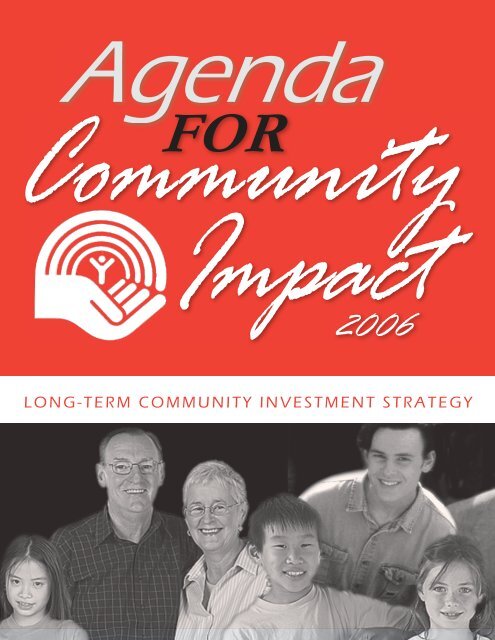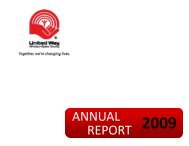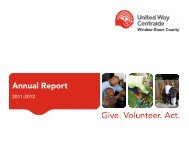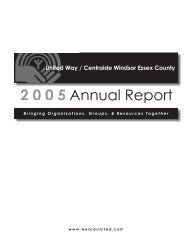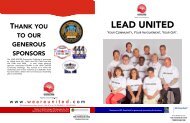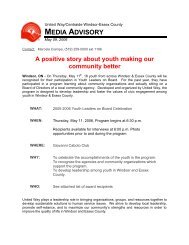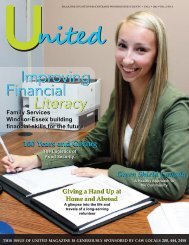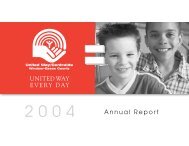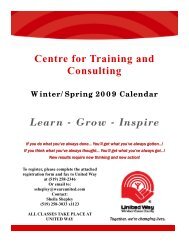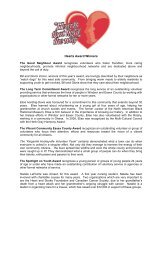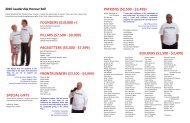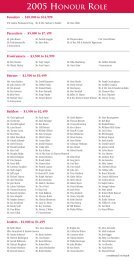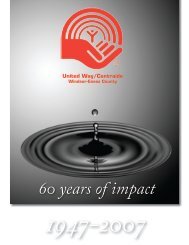Agenda for Community Impact - United Way / Centraide Windsor ...
Agenda for Community Impact - United Way / Centraide Windsor ...
Agenda for Community Impact - United Way / Centraide Windsor ...
You also want an ePaper? Increase the reach of your titles
YUMPU automatically turns print PDFs into web optimized ePapers that Google loves.
<strong>Agenda</strong><br />
<strong>Community</strong><br />
FOR<br />
<strong>Impact</strong><br />
2006<br />
LONG-TERM COMMUNITY INVESTMENT STRATEGY
Table of Contents<br />
Introduction . . . . . . . . . . . . . . . . . . . . . . . . . . . . . . . . . . . . . . . . . . . . . . . . . . . . . . . . . . . . . . . . 2<br />
Making a Case <strong>for</strong> Change . . . . . . . . . . . . . . . . . . . . . . . . . . . . . . . . . . . . . . . . . . . . . . . . . . . . 3<br />
<strong>Community</strong> Building Framework . . . . . . . . . . . . . . . . . . . . . . . . . . . . . . . . . . . . . . . . . . . . . . .4<br />
Setting the Stage <strong>for</strong> <strong>Community</strong> Building . . . . . . . . . . . . . . . . . . . . . . . . . . . . . . . . . . . . . . 5<br />
<strong>United</strong> <strong>Way</strong> Investment Framework . . . . . . . . . . . . . . . . . . . . . . . . . . . . . . . . . . . . . . . . . . . .6<br />
Building a <strong>Community</strong> <strong>Agenda</strong> . . . . . . . . . . . . . . . . . . . . . . . . . . . . . . . . . . . . . . . . . . . . . . . . 7<br />
The <strong>Community</strong> Speaks . . . . . . . . . . . . . . . . . . . . . . . . . . . . . . . . . . . . . . . . . . . . . . . . . . . . . . . 8<br />
AGENDA FOR COMMUNITY IMPACT. . . . . . . . . . . . . . . . . . . . . . . . . . . . . . . . . . . . . . . . . . . 9<br />
Children and Youth . . . . . . . . . . . . . . . . . . . . . . . . . . . . . . . . . . . . . . . . . . . . . . . . . . . . 10<br />
Individuals and Families . . . . . . . . . . . . . . . . . . . . . . . . . . . . . . . . . . . . . . . . . . . . . . . . 14<br />
Persons with Disabilities . . . . . . . . . . . . . . . . . . . . . . . . . . . . . . . . . . . . . . . . . . . . . . . . 18<br />
Seniors . . . . . . . . . . . . . . . . . . . . . . . . . . . . . . . . . . . . . . . . . . . . . . . . . . . . . . . . . . . . . . . .20<br />
THE COMMUNITY SPEAKS . . . . . . . . . . . . . . . . . . . . . . . . . . . . . . . . . . . . . . . . . . . . . . . . . . . 22<br />
Elements of a Vibrant <strong>Community</strong> . . . . . . . . . . . . . . . . . . . . . . . . . . . . . . . . . . . . . . . 22<br />
From <strong>Community</strong> Speaks to <strong>Community</strong> Action . . . . . . . . . . . . . . . . . . . . . . . . . . .23<br />
Acknowledgements . . . . . . . . . . . . . . . . . . . . . . . . . . . . . . . . . . . . . . . . . . . . . . . . . . . . . . . . . 24<br />
AGENDA FOR COMMUNITY IMPACT
Introduction<br />
The <strong>Agenda</strong> <strong>for</strong> <strong>Community</strong> <strong>Impact</strong> is the result of five years of work and the culmination of thousands of hours<br />
of time spent by dedicated community volunteers who worked together and were guided by a single vision – to<br />
improve the quality of life <strong>for</strong> people in <strong>Windsor</strong>-Essex County. Embracing this new vision, our community has now<br />
taken an important first step to increase our collective capacity to make a dramatic difference in the lives of those<br />
who need help in our community.<br />
<strong>United</strong> <strong>Way</strong>’s focus has always been about community and caring, but the <strong>Agenda</strong> <strong>for</strong> <strong>Community</strong> <strong>Impact</strong> has<br />
created a shift toward <strong>United</strong> <strong>Way</strong> being recognized as a leader in community impact. <strong>United</strong> <strong>Way</strong>’s role extends<br />
beyond fundraising to bringing the community together on human service issues that can only successfully be<br />
addressed collectively.<br />
In the future, this community agenda will serve many functions that will benefit our community:<br />
• It will guide <strong>United</strong> <strong>Way</strong> investments, and be a resource <strong>for</strong> guiding the investment decisions of other funders<br />
and organizations. We can no longer fund independently of one another, without recognizing the positive impact<br />
of collective commitment of resources.<br />
• It will ensure that emerging programs and services are issue focused. More attention will be paid to answering<br />
the question, “What does the community need” rather than focusing on individual agency needs.<br />
• Most importantly, the <strong>Agenda</strong> <strong>for</strong> <strong>Community</strong> <strong>Impact</strong> is focused on the future. Planning will be centred on<br />
<strong>for</strong>ming partnerships and developing long-term strategies <strong>for</strong> sustainable community change.<br />
The Report that follows:<br />
• Summarizes the conditions that required the need to change, and how these changes can benefit our<br />
community;<br />
• Defines <strong>Community</strong> Building and its underlying goals and principles;<br />
• Outlines the activities that set the stage <strong>for</strong> <strong>Community</strong> Building and prepared our <strong>Community</strong> <strong>for</strong> this<br />
dynamic trans<strong>for</strong>mation toward building a community agenda; and<br />
• Presents the work of Strategy Teams which identified, with community consultation, Areas of Concern and<br />
Recommendations that <strong>for</strong>m the basis <strong>for</strong> the <strong>Agenda</strong> <strong>for</strong> <strong>Community</strong> <strong>Impact</strong>.<br />
This <strong>Agenda</strong> <strong>for</strong> <strong>Community</strong> <strong>Impact</strong> is intended to be embraced by the entire community. As you read this Report<br />
think about ways in which you, your organization, or perhaps your neighbourhood are affected by this agenda<br />
and what role you can play in moving our community agenda <strong>for</strong>ward to improve the quality of life <strong>for</strong> all of us in<br />
<strong>Windsor</strong>-Essex County.<br />
2<br />
UNITED WAY/CENTRAIDE - WINDSOR-ESSEX COUNTY
MAKING A<br />
Case <strong>for</strong> Change<br />
In 1999, <strong>United</strong> <strong>Way</strong>/<strong>Centraide</strong> <strong>Windsor</strong>-Essex County Board of Directors<br />
undertook a review of its activities to make sure that it remained<br />
relevant, given the number of changes happening in the community. This<br />
internal reflection resulted in a refocus and return to our Core Purpose,<br />
to be a “resource to the total community”. It is the role of <strong>United</strong> <strong>Way</strong>, in<br />
partnership with the community, to ensure that programs and services<br />
funded continue to meet the changing needs in our community.<br />
And our community was changing; the nature of the challenges and<br />
problems is becoming more and more complex. Given this situation the<br />
board recognized that, to continue to be effective, the way that <strong>United</strong> <strong>Way</strong><br />
carries out its role as a resource also needed to change.<br />
In October 2001, a paper titled, “The <strong>Way</strong> of the Future, Building a Strong<br />
<strong>Community</strong> – Neighbourhood By Neighbourhood,” was presented to the<br />
community by <strong>United</strong> <strong>Way</strong>. The Paper outlined the impact of changes to<br />
the health and social services system, the implications of these changes,<br />
and <strong>United</strong> <strong>Way</strong>’s role in planning <strong>for</strong> community response.<br />
The changes in our community included:<br />
· Population growth, particularly in many of the County<br />
municipalities;<br />
· Changing demographics, including an increase in diversity<br />
provides new opportunities and<br />
challenges;<br />
· A shift in government and core services and funding<br />
priorities;<br />
· Changes in the Voluntary sector;<br />
· Increased competition <strong>for</strong> funding;<br />
· Recognition of the complexity of many issues in our<br />
community and the need to address the root causes of<br />
problems.<br />
Despite all the money raised and the services <strong>United</strong> <strong>Way</strong> and others<br />
provide, many problems in our community are growing. To address these<br />
complex issues there is a need to deal with the root causes that create<br />
them.<br />
This means new ways of thinking and new actions. A <strong>Community</strong> Building<br />
Framework was identified as the most effective way to make this happen.<br />
A SNAPSHOT OF<br />
<strong>Windsor</strong> - Essex County<br />
· The total population of<br />
<strong>Windsor</strong>-Essex County<br />
is 374,975 (2001), an<br />
increase of 7% in the five<br />
years between 1996 and<br />
2001;<br />
· The immigrant population<br />
represents 21.5% of the<br />
total population in our<br />
community (2001); we<br />
are the 4th most diverse<br />
community in Canada;<br />
· 33% of our local labour<br />
<strong>for</strong>ce participate in<br />
Manufacturing and<br />
Construction and this area<br />
remains the top industry;<br />
· Lone parent families<br />
have become a<br />
significant presence in<br />
our community, LaSalle,<br />
Tecumseh, and Kingsville<br />
have experience significant<br />
increases in the number<br />
of lone parent, primarily<br />
female-led families;<br />
· Of the total number<br />
of private dwellings in<br />
<strong>Windsor</strong>-Essex County,<br />
73% are owned, and 27%<br />
are rented;<br />
· In 2004, there were 59<br />
family physicians per<br />
100,000 people in our<br />
community, compared to<br />
85 physicians per 100,000<br />
in Ontario.<br />
AGENDA FOR COMMUNITY IMPACT<br />
3
C<br />
ommunity<br />
COMMUNITY BUILDING<br />
Framework<br />
Building may be, <strong>for</strong> some, a new way of thinking. It is a shift in focus from needs<br />
and problems to recognizing and building upon assets and opportunities. It has, at its roots, core<br />
principles that include building on strengths of individuals and organizations, promoting relationships,<br />
and leveraging all the resources and skills of the total community. It is a proven model <strong>for</strong> addressing<br />
complex community issues and connects people with solutions, and sets priorities <strong>for</strong> getting to the<br />
causes of social issues.<br />
Principles<br />
• Build on strengths of local individuals, associations and organizations.<br />
• Focus on specific actions and measurable results to improve community life.<br />
• Promote relationships among and participations of all races, genders, ages and cultures.<br />
• Ensure local decision-making and ownership.<br />
• Draw on resources of the total community.<br />
Strategies<br />
Identification<br />
Examples is an Asset<br />
Inventory<br />
Intervention<br />
Examples are<br />
Consultation,<br />
Training, Technology<br />
Development, <strong>Community</strong><br />
Development and<br />
Evaluation<br />
Investment<br />
Examples are Member<br />
Agency Funding, Grants,<br />
Volunteers<br />
<strong>Community</strong> Capacity<br />
is the interaction with<br />
human, organizational<br />
and social capital<br />
existing within a given<br />
community that can<br />
be leveraged to solve<br />
collective problems and<br />
improve or maintain the<br />
well being of a given<br />
community.<br />
Long Term Goals<br />
• Empower people<br />
• Increase community<br />
partnership<br />
• Foster social cohesion<br />
• Enhance cultural identity<br />
• Strengthen institutional<br />
development<br />
4<br />
From NEW LANGUAGE To<br />
Needs<br />
Assets<br />
Problems<br />
Opportunities<br />
Charity<br />
Investments<br />
Emphasis On Agencies Emphasis On Associations,<br />
Businesses And Agencies<br />
More Services<br />
Less Services<br />
Clients<br />
Citizens<br />
Programs are the answer People are the answer<br />
UNITED WAY/CENTRAIDE - WINDSOR-ESSEX COUNTY
SETTING THE STAGE FOR<br />
<strong>Community</strong> Building<br />
While the <strong>United</strong> <strong>Way</strong> remain committed to the<br />
funding of a network of services that contribute<br />
to the well-being of our community, this is not enough.<br />
The shift to <strong>Community</strong> Building focuses on mobilizing<br />
all people and resources in the community through<br />
partnerships that go well beyond dollars pledged and<br />
the many programs and services these dollars and<br />
people support. These community partners must<br />
include schools, governments, businesses, labour,<br />
voluntary associations, agencies, the faith community<br />
and others working together to change the conditions<br />
and improve the lives of people in the community,<br />
not just one organization, one group, or one sector.<br />
<strong>Community</strong> Building means the whole community<br />
must recognize, support, and take action to work<br />
toward meaningful change. It means a commitment<br />
to focus on the root causes of problems and mobilize<br />
our community to create lasting changes in community<br />
conditions, while still providing these support services<br />
<strong>for</strong> our residents.<br />
Recognizing Diversity<br />
The changes in demographics in our community and the increase in diversity have<br />
resulted in <strong>Windsor</strong>-Essex County becoming the 4th most diverse community<br />
in Canada. <strong>Community</strong> Building includes promoting relationships among<br />
all cultures, as well as fostering social cohesion and enhancing cultural<br />
identity. To get a full perspective that was representative of our<br />
community, the Ethnocultural Advisory Committee was <strong>for</strong>med.<br />
This Committee represents the seven regions of the world. Their<br />
task was to provide advice and ensure that any Areas of Concern<br />
and subsequent Recommendations considered, and included,<br />
various cultural perspectives.<br />
In Partnership with Funders<br />
Because of the shift in government funding priorities and the<br />
increased competition <strong>for</strong> funding, it was necessary to <strong>for</strong>m<br />
solid partnerships with the various funders who provide<br />
financial resources to our community. As a result, the<br />
Funders Forum was created as a method <strong>for</strong> networking<br />
and communicating with funders to ensure they are aware<br />
and can identify their roles once the community agenda was<br />
established.<br />
Outcomes and <strong>Impact</strong><br />
To more effectively determine community impact, service<br />
programs require well identified outcomes and indicators<br />
to measure and monitor the impact of their programs.<br />
It is no longer enough to record that people simply go to<br />
programs. We need to know if a program made a difference<br />
in a person’s life. Since 2000, all <strong>United</strong> <strong>Way</strong> funded<br />
programs have been required to develop a program<br />
outcomes system to measure the impact their programs<br />
are having on participants and the community.<br />
In addition, workshops on outcomes and indicators<br />
were offered to community organizations.<br />
AGENDA FOR COMMUNITY IMPACT<br />
5
UNITED WAY<br />
Investment Framework<br />
The Lofquist Model provides a simple, yet powerful<br />
tool <strong>for</strong> capturing different comminity roles. Used<br />
as part of the <strong>United</strong> <strong>Way</strong> Investment Framework, the<br />
Lofquist model places an emphasis on prevention,<br />
which is consistent with addressing root causes.<br />
Prevention is an active process <strong>for</strong> creating conditions<br />
that promote the wellbeing of people. Remediation<br />
involves taking corrective action to rectify or bring about<br />
change <strong>for</strong> a recognized problem or need. The matrix<br />
identifies two types of prevention activities, community<br />
development and personal growth and development,<br />
and two types of remediation activities, community<br />
problem solving and personal problem solving.<br />
In 2001, <strong>United</strong> <strong>Way</strong>, in alignment with <strong>Community</strong><br />
Building principles, began educating funded agencies<br />
to ensure that both these agencies and the community<br />
was aware that <strong>United</strong> <strong>Way</strong> will shift some funds<br />
from remediation programs and services to those<br />
that focused on prevention in its move to community<br />
building.<br />
ARENAS OF HUMAN SERVICE ACTIVITY<br />
PURPOSE<br />
Prevention<br />
Remediation<br />
FOCUS<br />
Individuals Conditions<br />
1. <strong>Community</strong><br />
Development<br />
2. Personal<br />
Growth and<br />
Development<br />
3. <strong>Community</strong><br />
Problem<br />
Solving<br />
4. Personal<br />
Problem<br />
Solving<br />
<strong>Community</strong> Development (Quadrant 1)<br />
· Activities having prevention as their purpose and<br />
focusing on broad conditions;<br />
· Some examples are community assessment,<br />
community planning, community education, training,<br />
advocacy (<strong>for</strong> changes in conditions), and policy<br />
development.<br />
Personal Growth and Development (Quadrant 2)<br />
· Ef<strong>for</strong>ts to promote personal growth and<br />
development with individuals;<br />
· Examples are the development of leadership and<br />
decision-making skills, technical skills, and positive<br />
self-concepts.<br />
<strong>Community</strong> Problem Solving (Quadrant 3)<br />
· Conditions that have created problems and require<br />
some kind of corrective or remedial action;<br />
· The response to conditions is essentially reactive<br />
because there is a recognized need that requires<br />
corrective action, such as high unemployment, a<br />
rise in the crime rate, violence and vandalism in the<br />
neighbourhoods.<br />
Personal Problem Solving (Quadrant 4)<br />
· Individual treatment and various kinds of remedial<br />
ef<strong>for</strong>ts related to particular needs or problems;<br />
Activities of this arena usually are focused on<br />
individual change, such as group therapy, family<br />
treatment, and group homes.<br />
6<br />
UNITED WAY/CENTRAIDE - WINDSOR-ESSEX COUNTY
BUILDING A<br />
<strong>Community</strong> <strong>Agenda</strong><br />
Because the Long-Term <strong>Community</strong> Investment Strategy was designed to be a five-year process, several<br />
strategies and activities took place during this time to help increase awareness about the dynamic shift<br />
toward <strong>Community</strong> Building. Some strategies emphasized planning <strong>for</strong> the total community, while others involved<br />
aligning <strong>United</strong> <strong>Way</strong> investments <strong>for</strong> the community.<br />
Strategy 1: <strong>United</strong> <strong>Way</strong> as <strong>Community</strong> Builder<br />
• Acceptance of <strong>Community</strong> Building Framework.<br />
Strategy 2: <strong>Community</strong> Education<br />
• <strong>Community</strong> education to increase knowledge and understanding<br />
of <strong>Community</strong> Building, Program Outcomes, and <strong>United</strong> <strong>Way</strong>’s<br />
roles and resources.<br />
Strategy 3: Existing <strong>Community</strong> Investments<br />
• Continued investment in programs and services with a<br />
measurable impact in these areas:<br />
- Children & Youth<br />
- Individuals & Families<br />
- Persons with Disabilities<br />
- Seniors<br />
- <strong>Community</strong> Supports, Volunteers<br />
Strategy 4: New Investment Strategies<br />
• Establish new investment strategies through <strong>Community</strong> Building<br />
Grants, based on availability of financial resources.<br />
Strategy 5: Transition Plan<br />
• Develop a five-year transition plan to assist Funded Agencies to<br />
move toward a <strong>Community</strong> Building Framework.<br />
Strategy 6: <strong>United</strong> <strong>Way</strong> Operations<br />
• Align human and financial resources to new <strong>Community</strong> Building<br />
Framework and new roles as a “resource to the community”.<br />
Strategy 7: Planning Advisory Group<br />
• Form a Planning Advisory Group to oversee the planning process.<br />
Strategy 8: Implementation<br />
• Develop action plans <strong>for</strong> all strategies with specific activities,<br />
timelines that includes community involvement.<br />
Strategy 9: <strong>Community</strong> Engagement<br />
• Continue involvement of community through five strategy teams:<br />
Children & Youth, Individuals & Families, Persons with Disabilities,<br />
Seniors, <strong>Community</strong> Supports, as well as the Funders Forum,<br />
Ethnocultural Advisory Committee, website, Well-Being Report.<br />
AGENDA FOR COMMUNITY IMPACT<br />
7
THE COMMUNITY<br />
Speaks<br />
To make sure that the <strong>Agenda</strong> <strong>for</strong> <strong>Community</strong> <strong>Impact</strong> reflected the needs of the community, several activities<br />
were undertaken to engage the community and allow <strong>for</strong> a variety of community perspectives. This was<br />
accomplished through the <strong>for</strong>mation and work of the five Strategy Teams, which represented each of the following<br />
five impact areas:<br />
CHILDREN AND<br />
YOUTH<br />
INDIVIDUALS<br />
AND FAMILIES<br />
PERSONS WITH<br />
DISABILITIES<br />
SENIORS<br />
COMMUNITY<br />
SUPPORTS<br />
Composition of<br />
Strategy Teams<br />
(6-8 members)<br />
• <strong>Community</strong> Citizens<br />
• Service Providers/<br />
<strong>Community</strong> Organizations<br />
• <strong>United</strong> <strong>Way</strong> Funded<br />
Agencies<br />
Each Strategy Team, guided by their Purpose and Goal Statements,<br />
progressed through a similar process.<br />
• Review community demographics and relevant documents and research and LISTEN to the<br />
community when they respond to the question – “What are the Areas of Concern”;<br />
• Develop a PLAN that identified Areas of Concern;<br />
• VALIDATE these Areas of Concern in the community through focus groups and community <strong>for</strong>ums;<br />
• RECOMMEND solutions to these Areas of Concern. Recommendations that are vetted through a<br />
<strong>Community</strong> Building “lens” to make sure they support principles and goals of <strong>Community</strong> Building;<br />
• Now is the time to ACT on these Recommendations by developing strategies;<br />
• Develop methods to MEASURE impact on individuals and the community.<br />
8<br />
UNITED WAY/CENTRAIDE - WINDSOR-ESSEX COUNTY
AGENDA FOR COMMUNITY IMPACT<br />
T<br />
he following pages represent the work of the five Strategy Teams. Each section<br />
presents the holistic model <strong>for</strong> that impact area, as well as identified Areas of Concern<br />
and Recommendations.<br />
BUILDING HOLISTIC MODELS<br />
Each one of us, whether a child, senior, member of a family, or person with a disability,<br />
needs specific conditions to be in place in order to develop and thrive as individuals.<br />
Recognizing this, each Strategy Team has developed a holistic model that captured the<br />
essential elements that contribute to our quality of life. The Models were developed after<br />
reviewing research and models developed by other communities.<br />
RECOMMENDATIONS<br />
The final outcome of the Planning Phase was the identification of Areas of Concern<br />
and the development of Recommendations regarding the Areas of Concerns. Areas<br />
of Concern are issues or gaps in services that were validated through community<br />
consultations and focus groups. Recommendations were developed by four Strategy<br />
Teams: Children & Youth, Individuals & Families, Persons with Disabilities, and Seniors.<br />
A fifth Strategy Team which touches on all aspects of the community, The <strong>Community</strong><br />
Supports Strategy Team, identified the elements of a vibrant community, which provided a<br />
framework <strong>for</strong> the process. This model is provided on page 22 of this document.<br />
The Recommendations will guide the entire community as we continue to build<br />
community capacity, <strong>for</strong>m partnerships, and build the <strong>Agenda</strong> <strong>for</strong> <strong>Community</strong> <strong>Impact</strong>.<br />
AGENDA FOR COMMUNITY IMPACT<br />
9
A SNAPSHOT OF<br />
CHILDREN AND<br />
YOUTH IN<br />
<strong>Windsor</strong> - Essex County<br />
• % of total population<br />
aged 0-19 yrs:<br />
LaSalle - 30.6%<br />
Lakeshore - 29.6%<br />
Tecumseh - 29.5%<br />
Amherstburg - 28.8%<br />
Leamington - 28.6%<br />
Essex - 27.7%<br />
Kingsville - 27.1%<br />
<strong>Windsor</strong> – 25.2%<br />
• In 2004, of the 162,741<br />
meals served at local<br />
food banks, 73,067 were<br />
<strong>for</strong> children;<br />
• In Canada, the obesity<br />
rate among children<br />
aged 12-17 years has<br />
increased from 3% in<br />
1979 to 9% in 2004;<br />
• In 2004, Children’s Crisis<br />
Services responded to<br />
1,630 requests <strong>for</strong> crisis<br />
intervention <strong>for</strong> children;<br />
HEALTHY DEVELOPMENT MODEL<br />
Children and Youth<br />
ll interventions and activities <strong>for</strong> children and youth are undertaken<br />
Aadhering A to principles of respect, participation, equity, security, and<br />
nurturance.<br />
PHYSICAL<br />
WELL-BEING<br />
• Adequate food and<br />
COMMUNITY, SCHOOLS, NEIGHBOURHOODS<br />
FAMILY<br />
•<br />
•<br />
•<br />
EMOTIONAL GROWTH<br />
& DEVELOPMENT<br />
LEARNING READINESS<br />
Access to adequate education<br />
Access to school-aged child care<br />
Opportunities to develop and explore<br />
sense of self<br />
School engagement<br />
•<br />
clothing<br />
• Freedom from harm and<br />
neglect<br />
• Clean and healthy<br />
environment<br />
• Stable and secure housing<br />
• Access to health care and<br />
mental health services<br />
• Adults take responsibility<br />
<strong>for</strong> children<br />
• Attachment to a caring adult<br />
• Positive identity and self-esteem<br />
• Effective planning and decision<br />
making<br />
• Adequate coping skills<br />
• Peaceful method <strong>for</strong><br />
resolving conflict<br />
MODEL<br />
SPIRITUALITY<br />
& VALUE<br />
STRUCTURE<br />
•<br />
•<br />
•<br />
•<br />
•<br />
SOCIETAL<br />
ENGAGEMENT<br />
& COMPETENCE<br />
• Interpersonal skills<br />
• Positive relationships<br />
• Cultural competence<br />
• Effective communication<br />
and listening<br />
• Engaging in leisure time<br />
and play<br />
• Meaningful role in<br />
community<br />
(civic engagement)<br />
Established positive values<br />
Method of expressing spirituality<br />
Respect <strong>for</strong> diversity- cultures,<br />
opinions, etc.<br />
Empathy <strong>for</strong> others<br />
Service to others<br />
PUBLIC POLICY<br />
• 14.4% of children are<br />
living in low-income<br />
households (2001);<br />
• In 2004/2005, there<br />
were 2,693 child abuse<br />
referrals to Children’s<br />
Aid Society.<br />
Sources: Middle Childhood Matters:<br />
CHEO, Child & Youth Health<br />
Network <strong>for</strong> Eastern Ontario, <strong>United</strong><br />
<strong>Way</strong> - Ottawa, Search Institute,<br />
Cevelopmental Assets.<br />
10<br />
UNITED WAY/CENTRAIDE - WINDSOR-ESSEX COUNTY
AREAS OF CONCERN FOR<br />
Children and Youth<br />
Areas of Concern are issues or gaps in important services identified by the Strategy Team and indicated<br />
by the <strong>Community</strong> through a number of focus groups. The Areas of Concern as presented in the<br />
Children and Youth model <strong>for</strong>m the basis <strong>for</strong> the Recommendations in the area of Children and Youth.<br />
LEARNING READINESS<br />
• (7-12yrs) Limited Availability of after-school<br />
literacy programs especially fully subsidized<br />
programs<br />
• (13-18yrs) Limited literacy programs<br />
PHYSICAL designed to assist youth to stay in school<br />
SOCIETAL<br />
WELL-BEING and/or secure employment<br />
ENGAGEMENT<br />
• (16-18 yrs) Absence • (13-18yrs) Concern regarding & COMPETENCE<br />
of more intensive treatment role of guidance counselors<br />
and expectations of<br />
students<br />
COMMUNITY, SCHOOLS, NEIGHBOURHOODS<br />
programs <strong>for</strong> addiction issues,<br />
self-esteem<br />
• (7-12, 13-18) Inadequate<br />
mental health services<br />
• (Parents) Lack of timely access<br />
to supports in times of crisis,<br />
particularly <strong>for</strong> rural areas<br />
• (Parents) Inadequate basic<br />
needs supports <strong>for</strong> low-income<br />
families, especially<br />
working poor<br />
FAMILY<br />
EMOTIONAL GROWTH<br />
& DEVELOPMENT<br />
• (7-12yrs) Limited prevention and<br />
early intervention initiatives<br />
• (13-18yrs) Limited prevention<br />
and early intervention<br />
initiatives<br />
AREAS OF<br />
CONCERN<br />
SPIRITUALITY<br />
& VALUE<br />
STRUCTURE<br />
• (7-12, 13-18) Inconsistent<br />
access to a variety of social<br />
and recreational opportunities;<br />
• (7-12 yrs) Inconsistent access <strong>for</strong><br />
parents and children to in<strong>for</strong>mation on<br />
programs and resources available;<br />
• (13-18 yrs) Limited opportunities to<br />
identify issues that concern youth<br />
and participate in planning and<br />
decision-making processes;<br />
• (Parents) Limited availability and<br />
accessibility to parenting education<br />
programs (esp. 6 yrs +)<br />
• (Parents) Limited innovative<br />
service delivery methods <strong>for</strong><br />
parents who have diffi culty<br />
• (7-12yrs) Waning attitudes<br />
toward civic responsibility and<br />
participation<br />
access parenting programs;<br />
• (Parents) Limited parent<br />
support opportunities<br />
PUBLIC POLICY<br />
AGENDA FOR COMMUNITY IMPACT 11
RECOMMENDATIONS FOR<br />
Children and Youth<br />
Learning Readiness<br />
Advocate on behalf of Children and Youth to funders about the role of after-school programs and the impact on literacy<br />
and strengthening with the goal of removing the barriers to accessibility.<br />
Increase number of after school programs building on the current assets in <strong>Windsor</strong>-Essex County.<br />
Ensure service providers include in their programs literacy, social skills, and other activities that strengthen children’s<br />
assets.<br />
Work with school system to identify alternative creative strategies to address literacy needs.<br />
Clarify the role of Guidance Counselors <strong>for</strong> the students.<br />
Encourage consistent application of the role of Guidance Counselors across the education system.<br />
Societal Engagement & Competence<br />
Advocate to funders and program administrators to reduce multiple barriers <strong>for</strong> accessibility to ensure equal access to<br />
recreation services.<br />
Advocate that subsidized social and recreational services are provided in the event National Child Benefit funding is<br />
eliminated.<br />
Encourage coordination between educational institutions and service providers to ensure there is distribution /<br />
dissemination of comprehensive, up to date in<strong>for</strong>mation about resources available to parents and children.<br />
Increase opportunities <strong>for</strong> youth to participate in creating solutions regarding areas that affect them.<br />
Increase opportunities <strong>for</strong> parents to participate in learning activities.<br />
Identify and reduce barriers <strong>for</strong> accessibility to learning opportunities <strong>for</strong> effective parenting.<br />
Work with organizations to identify alternative creative strategies that will increase the number of parent support<br />
opportunities.<br />
12<br />
UNITED WAY/CENTRAIDE - WINDSOR-ESSEX COUNTY
RECOMMENDATIONS FOR<br />
Children and Youth<br />
Spirituality & Value Structure<br />
Develop strategies that change attitudes towards civic responsibility among youth ages 7-18 and celebrate their<br />
participation.<br />
Increase meaningful opportunities that engage youth in civic activities and eliminate barriers to participation.<br />
Emotional Growth & Development<br />
(7-12, 13-18 yrs) Advocate to service providers and educational institutions about the critical importance of<br />
incorporating prevention and early intervention education into their programs and services.<br />
(7-12, 13-18 yrs) Increase the number of opportunities <strong>for</strong> children to participate in these prevention and early<br />
intervention programs.<br />
Physical Well-Being<br />
Advocate within the current addictions treatment system to identify and implement strategies that meet the needs of 16-<br />
18 year olds.<br />
Increase the number of opportunities/resources that focus on the prevention of mental health issues in children and<br />
youth.<br />
Increase the number of opportunities / resources that will provide early identification and intervention <strong>for</strong> mental health<br />
issues in children and youth.<br />
Advocate on behalf of children and youth within the current Mental Health System to identify and implement strategies<br />
<strong>for</strong> 16-18 year olds.<br />
Advocate on behalf of parents with existing crisis support providers to address the needs of rural families who require<br />
timely access to crisis supports.<br />
Develop preventative strategies that assist in reducing the number of families that require crisis supports.<br />
Expand services to address needs of families in crisis by building on community assets.<br />
Increase awareness and accessibility to in<strong>for</strong>mation about services available to low-income families.<br />
Advocate on behalf of parents to funders and government agencies to increase funding <strong>for</strong> basic needs to ensure these<br />
supports are adequate and meet the needs of low-income families.<br />
Advocate on behalf of parents to funders / organizations to remove barriers that prevent the working poor from<br />
accessing these basic needs supports.<br />
AGENDA FOR COMMUNITY IMPACT 13
A SNAPSHOT OF<br />
INDIVIDUALS<br />
AND FAMILIES<br />
<strong>Windsor</strong> - Essex County<br />
• % of Families that are<br />
Lone Parent (2001):<br />
<strong>Windsor</strong> - 19.9%<br />
Essex - 13.5%<br />
Amherstburg - 12.1%<br />
Kingsville - 11.5%<br />
Tecumseh - 11%<br />
Leamington - 10.8%<br />
LaSalle - 9.9%<br />
Lakeshore - 9.9%<br />
• Median Family Income<br />
(2001)<br />
All Families - $64,952<br />
Lone Parent - $34,028<br />
• 42.3% of renters spend<br />
more than 30% of<br />
household income on<br />
shelter costs, 22% of<br />
these spend more than<br />
50% on housing (2001);<br />
• In 2004, 162,741<br />
people were served at<br />
local food banks, an<br />
11% increase from the<br />
previous year;<br />
• % Living in low-income<br />
households:<br />
Families – 9.7%<br />
Single – 31.9%<br />
• 36.5% of individuals 18+<br />
years are overweight;<br />
16.6% are obese (2003);<br />
• 66.7% of residents<br />
reported “some life<br />
stress”, 23.2% report<br />
“quite a lot” of life stress.<br />
CHARACTERISTICS OF HEALTHY<br />
Individuals and Families<br />
Physical<br />
Security<br />
• Adequate food & clothing<br />
• Freedom from harm & neglect<br />
• Financial security<br />
• Clean & healthy environment<br />
• Access to opportunity to<br />
healthcare<br />
• Stable & secure housing<br />
• Adults take responsibility <strong>for</strong><br />
children<br />
Cognitive Skills<br />
• Engaged in learning<br />
• Opportunities to develop<br />
& explore sense of self<br />
• Access to adequate<br />
education<br />
• Effective methods of<br />
planning &<br />
decision-making<br />
•<br />
•<br />
•<br />
•<br />
•<br />
CHARACTERISTICS OF<br />
A HEALTHY FAMILY<br />
Physical Security<br />
Emotional Stability<br />
Cognitive Skills<br />
Social Interaction<br />
Value Structure<br />
Social Interaction<br />
• Effective communication<br />
& listening<br />
• Engage in play and humour<br />
• Established family rituals/<br />
traditions<br />
• Shared leisure time<br />
• Service to others<br />
• Other positive relationships<br />
(peers, friends)<br />
Emotional<br />
Stability<br />
• Appreciation <strong>for</strong> one another<br />
• Adequate coping skills<br />
• Respect <strong>for</strong> one another<br />
• Affirming & supporting one<br />
another<br />
• Promotes self-esteem of<br />
individual members<br />
• Sense of trust<br />
• Commitment to one another<br />
• Peaceful method of resolving<br />
conflict<br />
• Admits and seeks<br />
help <strong>for</strong> problems<br />
Value Structure<br />
• Established right &<br />
wrong<br />
• Method of expressing<br />
spirituality<br />
• Respect <strong>for</strong> privacy<br />
• Established family roles<br />
• Shared responsibility<br />
• Respect <strong>for</strong> diversity–<br />
culture, opinions,<br />
etc.<br />
14<br />
UNITED WAY/CENTRAIDE - WINDSOR-ESSEX COUNTY
AREAS OF CONCERN FOR<br />
Individuals and Families<br />
Areas of Concern are issues or gaps in important services identified by the Strategy Team and indicated<br />
by the <strong>Community</strong> through a number of focus groups. The Areas of Concern as presented in the<br />
Individuals and Families model <strong>for</strong>m the basis <strong>for</strong> the Recommendations in the area of Individuals and<br />
Families.<br />
Physical<br />
Security<br />
• Lack of programs and<br />
services available and<br />
accessible to individuals and<br />
families in the County.<br />
• Lack of supports <strong>for</strong> families<br />
and family members with special<br />
needs including mental health<br />
needs.<br />
• Lack of awareness and education<br />
of services <strong>for</strong> families who are<br />
experiencing all <strong>for</strong>ms of abuse.<br />
• Increase in the number of lowincome,<br />
working poor individuals and<br />
families who rely on basic need<br />
support services.<br />
• Limited af<strong>for</strong>dable, accessible,<br />
supportive housing based<br />
on the needs of the<br />
community.<br />
Cognitive Skills<br />
• Lack of innovative<br />
services delivery<br />
methods and resources <strong>for</strong><br />
health promotion and prevention<br />
education programs that<br />
recognize barriers to participation.<br />
• Limited appropriate parenting<br />
education programs that meet the<br />
needs of high-risk families.<br />
• Lack of integrated and<br />
coordinated services <strong>for</strong><br />
newcomers in areas of<br />
settlement, integration,<br />
and adaptation.<br />
AREAS OF<br />
CONCERN FOR<br />
INDIVIDUALS AND<br />
FAMILIES<br />
Social Interaction<br />
NONE<br />
Emotional<br />
Stability<br />
• Lack of coordinated<br />
services/opportunities<br />
available <strong>for</strong> individuals<br />
experiencing addictions<br />
and/or mental health<br />
issues.<br />
• Lack of appropriate,<br />
integrated, and responsive<br />
counseling services related<br />
to culturally diverse<br />
and marginalized<br />
populations.<br />
Value Structure<br />
• Established right & wrong.<br />
• Method of expressing<br />
spirituality.<br />
• Respect <strong>for</strong> privacy.<br />
• Established family roles.<br />
• Shared responsibility.<br />
• Respect <strong>for</strong> diversity–<br />
culture, opinions, etc.<br />
AGENDA FOR COMMUNITY IMPACT 15
Emotional Stability<br />
Identify and reduce barriers that impede the recovery process <strong>for</strong> addictions and/or mental health<br />
issues.<br />
Identify and remove barriers specific to special populations.<br />
RECOMMENDATIONS FOR<br />
Individuals and Families<br />
Review research and develop best practices to effectively address concurrent disorders – addictions<br />
and mental health issues.<br />
Determine the counseling needs of diverse and marginalized populations of <strong>Windsor</strong>-Essex County.<br />
Develop opportunities and partnerships in the counseling field to increase/improve ability to respond<br />
to needs of diverse and marginalized populations.<br />
Facilitate development of a community-based multicultural committee that would assist in the<br />
identification, integration, coordination, and provision of programs and services <strong>for</strong> newcomers.<br />
Develop opportunities <strong>for</strong> partnerships among health promotion and prevention education providers<br />
and the community to identify and address barriers to participation.<br />
Encourage and facilitate other community stakeholders to more actively include health promotion and<br />
prevention education into their organizational culture.<br />
Develop creative methods <strong>for</strong> delivering health promotion and educational materials based on best<br />
practices.<br />
Value Structure<br />
Develop a partnership model between culturally diverse community resources and mainstream<br />
agencies which will focus on diversity and inclusivity and motivate agencies to think about ways to<br />
facilitate a proactive approach in assisting diverse populations, including an outreach component.<br />
Cognitive Skills<br />
Conduct an inventory of criteria and eligibility of existing parenting education programs in order to<br />
determine gaps.<br />
Identify parenting education needs and preferences of high-risk families regarding content, location,<br />
delivery method, cultural diversity, etc.<br />
Create a collaborative committee to actively examine best practices and evaluate the community’s<br />
ability to effectively meet the parenting education needs of high-risk families.<br />
16<br />
UNITED WAY/CENTRAIDE - WINDSOR-ESSEX COUNTY
RECOMMENDATIONS FOR<br />
Individuals and Families<br />
Physical Security<br />
Conduct a comprehensive inventory of county services available with the goal of identifying specific<br />
needs/service gaps.<br />
Examine county programs that provide integrated services and identify additional opportunities <strong>for</strong><br />
collaboration.<br />
Identify and communicate eligibility and service criteria among programs to more accurately assess<br />
gaps.<br />
Conduct a survey/review with families to assess barriers that impact their ability to access supports.<br />
Increase community capacity to recognize and address elder abuse.<br />
Continue to develop an integrated community approach <strong>for</strong> the assessment and treatment of<br />
domestic violence.<br />
Conduct a comprehensive inventory to determine availability of services <strong>for</strong> individuals and families to<br />
meet their basic needs.<br />
Develop a community communication strategy to ensure awareness of available services.<br />
Develop strategies to provide abuse prevention education focusing on youth.<br />
Provide accessible and af<strong>for</strong>dable opportunities to develop skills that will increase individuals’<br />
employment potential.<br />
Provide on-going support that will assist individuals to maintain employment.<br />
Research and implement initiatives that provide early intervention and mentoring <strong>for</strong> marginalized<br />
individuals.<br />
Increase flexibility of community to determine criteria <strong>for</strong> occupancy and eligibility of existing housing<br />
stock based on changing needs of community.<br />
Provide a continuum of supports that will assist individuals to access, acquire, and sustain their<br />
housing.<br />
AGENDA FOR COMMUNITY IMPACT 17
A SNAPSHOT OF<br />
PERSONS WITH<br />
DISABILITIES IN<br />
<strong>Windsor</strong> - Essex County<br />
• Based on the Ontario<br />
average of 1 in 8<br />
people, 46,750 people<br />
in <strong>Windsor</strong>-Essex<br />
County have a disability<br />
which limits their daily<br />
activities.<br />
• 71% of families who<br />
have children with<br />
severe disabilities report<br />
a significant impact on<br />
family employment–<br />
31.8% were required to<br />
work fewer hours, and<br />
17% quit working;<br />
• Of those with disabilities<br />
between 15-64 years of<br />
age, 76% live with family<br />
who provide assistance;<br />
• In 2003, of the entire<br />
social housing/<br />
af<strong>for</strong>dable housing<br />
stock available in<br />
<strong>Windsor</strong>-Essex County,<br />
only 2% of housing<br />
units were modified<br />
to accommodate<br />
special needs and very<br />
few included support<br />
services.<br />
HOLISTIC VIEW OF WELLNESS FOR<br />
Persons with Disabilities<br />
Health, Wellness, & Security<br />
• Health & Wellness<br />
• Safety & Security<br />
• Income Security<br />
Areas of Concern are issues or gaps in important services identified by the Strategy Team<br />
and indicated by the <strong>Community</strong> through a number of focus groups. The Areas of Concern<br />
as presented in the Persons with Disabilities model <strong>for</strong>m the basis <strong>for</strong> the Recommendations<br />
in the area of Persons with Disabilities.<br />
Health,<br />
Wellness, & Security<br />
• Lack of opportunities and supports to<br />
secure employment;<br />
• Poor coordination among services/<br />
programs and funders;<br />
• Lack of af<strong>for</strong>dable, accessible,<br />
supportive housing based on<br />
the needs of the community.<br />
Supporting, Caring & Inclusive<br />
<strong>Community</strong><br />
• Living arrangements<br />
• Transportation<br />
• Attitude & Awareness<br />
• Social Isolation and Loneliness<br />
• Family/In<strong>for</strong>mal Caregiving<br />
Continuous Learning,<br />
Work, & Participation in Society<br />
• Work and retirement<br />
discrimination,<br />
• Negative Stereotyping,<br />
• Social Participation<br />
• Ethnocultural<br />
diversity<br />
Continuous Learning,<br />
Work, & Participation in Society<br />
• Limited individualized funding that would allow<br />
individuals to acquire customized services;<br />
• Physical Access– Lack of knowledge of barrier free<br />
design; legislation not en<strong>for</strong>ced or is lacking in terms of<br />
standards <strong>for</strong> barrier-free design;<br />
• Access to in<strong>for</strong>mation – Lack of a single access point <strong>for</strong><br />
individuals to get in<strong>for</strong>mation in a variety of <strong>for</strong>mats;<br />
• Lack of services <strong>for</strong> youth aged 16-18<br />
and young adults.<br />
Supporting,<br />
Caring & Inclusive <strong>Community</strong><br />
• Lack of coordinated, af<strong>for</strong>dable, reliable, accessible<br />
transportation services in the City and County;<br />
• Attitude & Awareness – Lack of recognition and respect <strong>for</strong><br />
individuals with disabilities, marginalization of persons<br />
with disabilities;<br />
• Strict criteria create barriers <strong>for</strong> accessibility<br />
<strong>for</strong> services and programs.<br />
18<br />
UNITED WAY/CENTRAIDE - WINDSOR-ESSEX COUNTY
RECOMMENDATIONS FOR<br />
Persons with Disabilities<br />
Health, Wellness, & Security<br />
For existing employment programs, provide appropriate and on-going supports that meet the needs of<br />
persons seeking, securing, and maintaining employment.<br />
Educate employers regarding available accommodations and funding to provide employment<br />
opportunities <strong>for</strong> individuals with disabilities.<br />
Advocate to funders about the importance of coordination of supports to respond to the individual<br />
needs of persons with disabilities and their families.<br />
Increase the numbers of af<strong>for</strong>dable, accessible, supportive housing available in communities in<br />
<strong>Windsor</strong>-Essex County.<br />
Increase funding available to persons with disabilities and their families to make adaptation<br />
requirements to their existing homes.<br />
Continuous Learning, Work, & Participation in Society<br />
Educate funders about the positive outcomes of individualized funding and advocate <strong>for</strong> increased<br />
availability of funding to enhance the capacity of persons with disabilities to live life to the fullest.<br />
Ensure universal accessibility <strong>for</strong> persons who have a disability by complying with the requirements of<br />
a Barrier-Free <strong>Community</strong>.<br />
Create one central place where persons with disabilities and their families can access in<strong>for</strong>mation<br />
that is available in all <strong>for</strong>mats and languages.<br />
Increase supports <strong>for</strong> youth with disabilities aged 16-18 yrs to successfully make life transitions and<br />
ensure full participation in their communities.<br />
Supportive, Caring, & Inclusive <strong>Community</strong><br />
Advocate <strong>for</strong> a single, coordinated para-transportation system that is af<strong>for</strong>dable, reliable, and<br />
accessible to the City and County residents.<br />
Increase the availability of accessible public transportation in the City and County.<br />
Educate the public about the abilities and contributions of individuals with disabilities.<br />
Advocate to service providers, educators, and funders regarding their mandated responsibility to<br />
increase community capacity to effectively respond to individuals with disabilities and their families.<br />
Empower persons with disabilities and their families to exercise their rights and enable them to<br />
successfully carry out their responsibilities.<br />
Advocate to funders (provincial and federal) to provide agencies with flexibility in eligibility/service<br />
criteria and adequate resources that meet the needs of individuals in a timely manner.<br />
19<br />
AGENDA FOR COMMUNITY IMPACT
A SNAPSHOT OF<br />
SENIORS IN<br />
<strong>Windsor</strong> - Essex County<br />
• The highest percentages<br />
of senior population in<br />
<strong>Windsor</strong>-Essex County<br />
are in Leamington<br />
(23.4%) and Kingsville<br />
(22.9%);<br />
• Seniors aged 65+ is<br />
expected to increase<br />
from 12.8% of overall<br />
population in 2001<br />
to16.8% in 2021;<br />
• In 2021, seniors aged<br />
85+ will account <strong>for</strong> 12%<br />
of the senior population;<br />
• In 2001, 56.5% of seniors<br />
had incomes below<br />
$20,000/yr;<br />
• Between 2004 and 2005,<br />
there were 322 known<br />
cases of elder abuse in<br />
<strong>Windsor</strong>-Essex County;<br />
42% financial abuse;<br />
35% physical abuse;<br />
13% psychological abuse;<br />
10% neglect;<br />
• 74% of elder abuse cases<br />
involve females, and 26%<br />
are males;<br />
• It is estimated that <strong>for</strong><br />
every reported case of<br />
abuse, 14 incidents go<br />
unreported;<br />
• In September 2005,<br />
850 people were on the<br />
waiting lists <strong>for</strong> long-term<br />
care facilities.<br />
HOLISTIC VIEW OF WELLNESS FOR<br />
Seniors<br />
Health, Wellness, & Security<br />
• Health & Wellness<br />
• Safety & Security<br />
• Income Security<br />
Supporting &<br />
Caring <strong>Community</strong><br />
• Living Arrangements<br />
• Transportation<br />
• Social Participation<br />
• Family/In<strong>for</strong>mal Caregiving<br />
• Value & Appreciation<br />
Continuous Learning,<br />
Work, & Participation in Society<br />
• Work & Retirement<br />
• Lifelong Learning<br />
Opportunities<br />
• Recreation & Leisure<br />
• Ethnocultural Diversity<br />
• Volunteerism<br />
Areas of Concern are issues or gaps in important services identified by the Strategy<br />
Team and indicated by the <strong>Community</strong> through a number of focus groups.<br />
The Areas of Concern as presented in the Seniors model <strong>for</strong>m the basis <strong>for</strong> the<br />
Recommendations in the area of Seniors.<br />
Health, Wellness, &<br />
Security<br />
• Elder Abuse<br />
•Safety Issues – Falls<br />
• Improper management<br />
of own health and<br />
wellness<br />
Continuous<br />
Learning, Work, &<br />
Participation in Society<br />
• Lack of in<strong>for</strong>mation/<br />
public awareness of services<br />
• Lack of culturally sensitive<br />
services <strong>for</strong> ethnocultural<br />
seniors<br />
Supporting,<br />
Caring & Inclusive <strong>Community</strong><br />
• Lack of transportation services<br />
• Limited home maintenance and repair services<br />
• Lack of caregiver supports<br />
• Lack of af<strong>for</strong>dable and supportive housing<br />
20<br />
UNITED WAY/CENTRAIDE - WINDSOR-ESSEX COUNTY
RECOMMENDATIONS FOR<br />
Seniors<br />
Health, Wellness, & Security<br />
Increase awareness and understanding of elder abuse in order to change negative behaviours and<br />
reduce incidence of elder abuse.<br />
Advocate on behalf of seniors that policy makers develop and implement improved policies that<br />
protect seniors who are victims of abuse.<br />
Increase resources that respond to the needs of vulnerable seniors and those experiencing elder<br />
abuse.<br />
Increase resources dedicated to helping to reduce incidences of slips and falls by seniors in our<br />
community and promote existence of these resources.<br />
Increase seniors’ capacity to successfully manage their own health and wellness.<br />
Continuous Learning, Work, & Participation in Society<br />
Create and promote a centralized in<strong>for</strong>mation and delivery system that can be accessed by seniors<br />
and their <strong>for</strong>mal/in<strong>for</strong>mal caregivers throughout <strong>Windsor</strong>-Essex County through various <strong>for</strong>mats.<br />
Increase the cultural competency of organizations to meet the needs of ethno-cultural seniors.<br />
Supportive, Caring, & Inclusive <strong>Community</strong><br />
Increase transportation options that are accessible and af<strong>for</strong>dable to all seniors.<br />
Develop an accredited and af<strong>for</strong>dable home maintenance and repair service which include subsidies<br />
<strong>for</strong> low-income seniors.<br />
Increase the amount and availability of caregiver support including respite, relief, and education <strong>for</strong><br />
<strong>for</strong>mal/in<strong>for</strong>mal caregivers.<br />
Create a variety of af<strong>for</strong>dable options and supports that will meet seniors’ housing needs.<br />
AGENDA FOR COMMUNITY IMPACT 21
ELEMENTS OF A<br />
Vibrant <strong>Community</strong><br />
• Leadership is diversified &<br />
representative of composition of<br />
community<br />
• Coordinated, mandated macro-level<br />
planning <strong>for</strong> community that is regularly<br />
evaluated<br />
• Adequate planning and<br />
maintenance <strong>for</strong> current and<br />
future infrastructure needs<br />
•<br />
•<br />
Planning / Leadership<br />
•<br />
•<br />
• Expanding diversified local<br />
economy with a wide range of<br />
employment opportunities<br />
Skilled, adaptable work<strong>for</strong>ce<br />
Regional economic development plan<br />
•<br />
Economy<br />
Transportation plan that<br />
supports the local, provincial,<br />
and national economies<br />
Health<br />
Equitable access to timely<br />
af<strong>for</strong>dable health care<br />
<strong>Community</strong> policies & strategies<br />
to promote healthy lifestyles<br />
& behaviors<br />
Support Networks<br />
•<br />
Equal access to basic needsfood,<br />
clothing, shelter<br />
• Continuum of services available <strong>for</strong><br />
all citizens including prevention,<br />
intervention, crisis, etc.<br />
• Strong, mutually supportive networks<br />
•<br />
Opportunities <strong>for</strong> attachment of<br />
personal and collective<br />
goals<br />
•<br />
<strong>Community</strong><br />
ELEMENTS OF<br />
A VIBRANT<br />
COMMUNITY<br />
Arts,<br />
Culture & Heritage<br />
• Recognize, celebrate<br />
and support arts,<br />
culture and heritage<br />
Civic Engagement /<br />
Volunteerism<br />
• Citizens involved in creation &<br />
implementation of a shared vision<br />
• Citizens are optimistic & have a sense of pride<br />
• Mechanism <strong>for</strong> providing knowledge,<br />
opportunity, and responsibility to participate<br />
in meaningful change<br />
• Strong voluntary sector that has an<br />
integral role in community<br />
Housing<br />
• Variety of housing<br />
stock to meet the<br />
needs of community<br />
including availability<br />
and af<strong>for</strong>dability<br />
Education<br />
• Support <strong>for</strong> education at all<br />
levels that is inclusive and<br />
responsive<br />
• Opportunities <strong>for</strong> life-long<br />
learning and skill development<br />
Safety & Security<br />
• Safe neighborhoods<br />
• Safe workplaces<br />
Transportation<br />
• Public transportation<br />
that is accessible and<br />
efficient<br />
Leisure & Recreation<br />
• Adequate availability and access<br />
to leisure & recreation facilities<br />
<strong>for</strong> all that is af<strong>for</strong>dable<br />
• System of linear, linked trails<br />
between neighborhoods<br />
Diversity / Inclusion<br />
• Multiculturalim accepted<br />
and valued<br />
• Fair & equitable access to<br />
community resources<br />
• Interaction & partnerships<br />
that support inclusion<br />
of all residents<br />
Environment<br />
• Adequate green<br />
space<br />
• Clean air, water, land<br />
• Responsible use of<br />
natural resources<br />
22<br />
UNITED WAY/CENTRAIDE - WINDSOR-ESSEX COUNTY
FROM COMMUNITY SPEAKS TO<br />
<strong>Community</strong> Action<br />
ith the completion of this planning phase and the development of a sound framework based on<br />
W community input and feedback, the <strong>United</strong> <strong>Way</strong> and the community can now move <strong>for</strong>ward with<br />
specific steps to fulfill the community agenda and create meaningful, sustainable change.<br />
Several actions will take place to support our community as it moves <strong>for</strong>ward in realizing this vision.<br />
<strong>Community</strong> <strong>Impact</strong> Advisory Committee (CIAC)<br />
The <strong>for</strong>mation of the CIAC will provide a mechanism <strong>for</strong> how the overall Recommendations can<br />
shape future planning activities, as well as Allocation decisions and processes. The CIAC will have<br />
representation from several sectors, as well as community residents who have been integrally involved<br />
with <strong>United</strong> <strong>Way</strong>’s Long-Term <strong>Community</strong> Investment Strategy, which evolved into the <strong>Agenda</strong> <strong>for</strong><br />
<strong>Community</strong> <strong>Impact</strong>. The CIAC will be responsible <strong>for</strong> processing these Recommendations, as well as<br />
developing and designing specific strategies <strong>for</strong> implementation.<br />
The Role of <strong>United</strong> <strong>Way</strong> in Partnership with the <strong>Community</strong>.<br />
As the catalyst <strong>for</strong> the community agenda, <strong>United</strong> <strong>Way</strong> will also define its role and involvement with<br />
respect to these Recommendations. <strong>United</strong> <strong>Way</strong> Board will review and vet the recommendations through<br />
“Three I’s”, in order to determine the appropriate response:<br />
Identification – “<strong>United</strong> <strong>Way</strong> as Catalyst”<br />
Recommendations and strategies may fall within mandated areas of other funders. In these<br />
instances, <strong>United</strong> <strong>Way</strong> will serve as an in<strong>for</strong>mation source and catalyst to advise the funder/<br />
mandated provider of this need, and partner on effective solutions.<br />
Intervention – “<strong>United</strong> <strong>Way</strong> as <strong>Community</strong> Developer”<br />
Recommendations may benefit from interventions such as consultative services, training,<br />
community development, and evaluation. In these cases, <strong>United</strong> <strong>Way</strong> will act as a resource<br />
and partner with other organizations and the community as we implement initiatives within a<br />
<strong>Community</strong> Building Framework.<br />
Investment – “<strong>United</strong> <strong>Way</strong> as Investor”<br />
Recommendations that are determined, through the Allocations Process, to fall within the new<br />
<strong>Community</strong> Building Investment Framework, may results in investment of <strong>United</strong> <strong>Way</strong> financial<br />
and/or human resources. These Recommendations will also be reviewed through the Lofquist<br />
Model.<br />
<strong>Community</strong> Building finds its success by building on community capacity and existing assets – the<br />
leadership, skills, resources, knowledge, and passion of individuals within communities. <strong>United</strong> <strong>Way</strong> will<br />
continue to educate and work with the total community as we move the community agenda <strong>for</strong>ward.<br />
The <strong>Agenda</strong> <strong>for</strong> <strong>Community</strong> <strong>Impact</strong> is a well-defined roadmap that will help us focus our attention, ef<strong>for</strong>ts,<br />
and resources. We all have a vision of our community – a community that will support the well-being <strong>for</strong><br />
ourselves, our children, our families, and each other, both now and in the future.<br />
23<br />
AGENDA FOR COMMUNITY IMPACT
Acknowledgements<br />
Planning Advisory Group<br />
• Anne Miskovsky<br />
• Melanie Gillespie<br />
• Michelle Burd<br />
Strategy Team Members<br />
• Jennifer McLean<br />
• Marina Clemens<br />
• Helen Hayward<br />
• Rene Jacques<br />
• Sandra McLean<br />
• Keith Simison<br />
• Ed Sleiman<br />
• Mary Berry<br />
• Graham Cooper<br />
• Amy Ouellette<br />
• Raj Patil<br />
• Marusia Preece<br />
• Gord Taylor<br />
• Helen Hayward<br />
• Ellen Hope<br />
• Joe Fenech<br />
• Jan Tultz<br />
• Tom Bannister<br />
• Tim Beaudette<br />
• Anne Marie Demers<br />
• Jeannie La<strong>for</strong>ge<br />
• Lisa Raffoul<br />
• Elaine Whitmore<br />
• Joyce Zuk<br />
• Joanne Brown<br />
• Paul Edwards<br />
• Karen Gignac<br />
• Harvey Kessler<br />
• Janet Palamides<br />
• Mary Ellen Bernard<br />
• Tim Ellard<br />
• Onorio D’Agostino<br />
• Margaret Ann Prince<br />
• Richard Gordon Taylor<br />
• Mary Lou Thibert<br />
• Jennifer Franklin-McGinnis<br />
• Lorraine Goddard<br />
• Catherine Johnson<br />
• Wendy Leigh<br />
• Allan Mifflin<br />
• Kit Moore<br />
• Susan Najem<br />
• Cecile Paquette-Crouchman<br />
• Jim Yanchula<br />
Ethnocultural Advisory Committee<br />
• Forouzandeh Boozari<br />
• Ahmer Kamal Rasool<br />
• Rose Hurst<br />
• Jacquie Rumiel<br />
• Asterie Ndikumana<br />
• Sr. Helen Petrimoulx<br />
• Kathleen Thomas<br />
• Angela Ventura<br />
Funders Forum<br />
• Ghislaine Brodeur<br />
• Michelle Burd<br />
• Brad Davies<br />
• Cliff Fast<br />
• Karen Kahelin<br />
• Mimi Lo<br />
• Martha McIntosh<br />
• Margaret McPherson<br />
We wish to thank the hundreds of members of the community who participated in this<br />
process as key in<strong>for</strong>mants. We would also like to thank the many community<br />
organizations who donated their time and resources.<br />
Special thanks to<br />
Nancy Adams, Yvonne Arnowitz, Lyn Bain, Russ Horrocks, and Linda Morrow<br />
<strong>for</strong> the development and design of the<br />
<strong>Agenda</strong> <strong>for</strong> <strong>Community</strong> <strong>Impact</strong><br />
24<br />
Thanks to our valuable partner,<br />
The Corporation of the City of <strong>Windsor</strong>,<br />
<strong>for</strong> their support in the printing of this<br />
document<br />
UNITED WAY/CENTRAIDE - WINDSOR-ESSEX COUNTY
UNITED WAY/CENTRAIDE WINDSOR-ESSEX COUNTY<br />
300 GILES BLVD. EAST, UNIT A-1, WINDSOR, ON N9A 4C4<br />
(519) 258-0000 Fax: (519) 258-2346<br />
Email: united@weareunited.com www.weareunited.com


